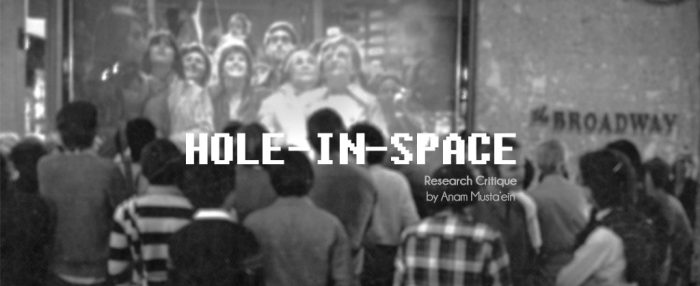“Hole–In–Space suddenly severed the distance between both cities and created an outrageous pedestrian intersection. There was the evening of discovery, followed by the evening of intentional word-of-mouth rendezvous, followed by a mass migration of families and trans–continental loved ones, some of which had not seen each other for over twenty years.”
– “The Social Machine: Designs for Living Online” by Judith Donath
Hole-in-Space has allowed the public to be comfortable to interact with strangers. The project by Kit Galloway and Sherrie Rabinowitz was a remarkable milestone in showing how telecommunication could bridge the physical distance between people from different places, and bring them together to interact in one cohesive space, live. The public communication sculpture, that went on for a total of three nights, consisted of two huge screens , a two-way satellite hookup, and two cameras that were set up in two different cities in the United States – one in Los Angeles, and the other in New York.
Without any prior information or any artist’s statement for the installation, the video that went live on the first night caught pedestrians and passer-by’s by surprise. The people were able to see and speak to each other with no media interruptions or any self-viewing cameras that might have made them overly self-conscience and impede them from genuine communication.
Viewers from the first night were so enthralled from the encounter that word-of-mouth and local news reports soon brought long-distant friends and families, whom in some cases have not seen one another in years, together in one space. For some, it led to several planned meetings on the second and third nights, bringing joy to many who were finally able to see their loved ones. While for others, the virtual space became a medium to integrate other forms of interaction fearlessly and spontaneously.
“A virtual space creates social situations without traditional rules of etiquette. The absence of the threat of physical harm makes people braver. Virtual space diminishes our fears of interaction.”
– “Welcome to ‘Electronic Cafe International’: A Nice Place for Hot Coffee, Iced Tea, & Virtual Space” (1992)
The reading highlighted one very important point Physical interactions often complies to the rules of social norms. The consideration of whether a certain behavior is socially acceptable or not often comes with everyday physical interactions. Some people might even be a little shy and awkward to express themselves when it comes to such. And these social bounds that we have contrived ourselves into hinders us from free expression. However, interactions in the virtual space breaks that mold. People tend to be far more spontaneous and candid with their social interactions in the third space.
Take Hole-in-Space for example; passer-by’s in the streets would not usually stop to communicate with each other. It took a huge screen, with people from a different geographical location, to allow them to be comfortable with saying “hello” and to express themselves. Virtual space is allowing people to be comfortable to interact with strangers.

Many good points about the nature of social interaction in the third space. It is true, as you point out, that virtual exchanges are often considered less inhibiting than the ones we experience in the physical, first space. This was why people were so engage with Hole in Space, they literally felt unafraid to say and communicate whatever they felt. For many who find social interaction awkward, again as you point out, the medium works to free them to engage in new and unexpected ways. This explains why we are so drawn to social media, yet we also need to be careful about neglecting the importance of face to face forms of communication.
I like your point on virtual interactions didn’t follow the social norms of that in a physical interaction. That one can be free to express, perhaps their alter ego, without being criticized so much. But the most interesting thing about this is that this is not virtual, it’s real. But from how you view it, it is virtual. This to me is the greatest paradox. Until time travel exists, it will always be a paradox.